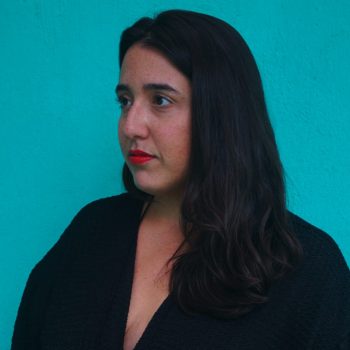This residency was organized through a collaboration with Beta-Local, Puerto Rico.

Marina Reyes Franco
Marina Reyes Franco (b. 1984) is an independent curator living and thinking from San Juan, Puerto Rico. Her graduate thesis at IDAES-UNSAM in Buenos Aires, expanded the notion of politically-motivated art and literature in 1970’s Puerto Rico, as evidenced by gestures, performances, and publications that had an unrecognized yet lasting impact continuing through the 2004 San Juan Poly/Graphic Triennial. Additionally, Reyes Franco is co-founder and former director of La Ene, a museum-as-project in Buenos Aires. She received the 2017 CPPC Travel Award for Central America and the Caribbean, and was nominated for the Independent Curators International 2014 Independent Vision Curatorial Award.
Interview January 2019 –
HPAC: TELL US A BIT ABOUT YOUR WORK AND APPROACH AS A CURATOR…
MRF: I first became interested in working in the art world after attending the 1st Poly/graphic Triennial of San Juan in 2004. I started writing about art and organizing exhibitions because I recognized how powerful they became to my own understanding of the world. As a researcher, I’m very interested in the social history of art and the artist as cultural worker; someone who generates actions on and about history. I have a long-standing interest in museums and rethinking institutional actions. In 2010 I co-founded La Ene with artist Gala Berger, a museum-as-institutional-critique project that was based in Buenos Aires and now operates in an itinerant basis. La Ene has organized exhibitions, seminars, workshops, lectures, and a residency for artists and curators that received more than 50 participants since its inception. We also established a memory-based collection that consists of documents and works of art that could be reproduced according to location and resources. More recent curatorial projects include co-curating, along with Pablo León de la Barra, Stefan Benchoam, and Radamés “Juni” Figueroa, the 2nd Grand Tropical Biennial in Loíza, Puerto Rico. Exchanging the white cube for the green, blue, and sandy one of a beach, we brought together artists from all over the world for an exhibition of works made or reinterpreted specifically for the setting. In 2017, I curated “Watch your step / Mind your head,” a two-woman show with Sofía Gallisá Muriente and Irene de Andrés Vega at Berlin’s ifa Galerie, as a first foray into our shared research about tourism as domination, the creation of palatable images of the tropics, and the idea of paradise, and the Caribbean, specifically Puerto Rico, as a site of re-signification of landscape and continued military and economic exploitation. I’m also involved in curatorial projects with the AFRO Corridor in Loíza, a platform to connect Afro descendent communities in Puerto Rico and the greater African Diaspora, as well as with Brigada PDT, an art and community-based organization in a San Juan neighborhood currently encroached by gentrifying efforts from all sides. I take a hands-on approach to arts management and exhibition-making, with a focus on the importance of agency and community, especially in the face of strong economic and colonial realities in Puerto Rico and abroad. I’m also an avid archivist and researcher, with a particular interest in what was been left out of official history. I value institutions as stewards of materials, works, and documents, as well as a centers for gatherings, producers of publications, and other intellectual activities. Nothing is mutually exclusive.
For the past three to four years, most of my curatorial research has been around the idea of tourism and the “visitor economy” in relation to the instrumentalization of the cultural sphere, as artists themselves become tools for economic development in economically depressed times. I am interested in the impact of tourism in cultural production and how the concepts of difference, otherness, and privilege are approached within the new colonial relationship that the tourism industry embodies, as well as the particular aesthetics that emerge from the transformations of lived environments. The ideas of paradise and fiscal paradises, and the geographical coincidence of these concepts, also highlight how art plays into the tax-haven phenomena, both as investment and as source of inspiration. The manicured tropics of landscape architecture and Instagram feeds that sell real estate, goods, and services to the new foreign investor or tourist, who inevitably hail from the same power centers that first colonized the land, make us wonder who constructs paradise as a concept, and who consumes it the most.
HPAC: WHAT ARE YOU MOST INTERESTED IN EXPLORING DURING YOUR TIME-IN RESIDENCE?
MRF: The visitor economy regime is prevalent in the Caribbean basin region, with its history of successive colonial governments, slave trade, neocolonial economic relationships, and tax-dodging schemes for transnational capital, but it’s by no means exclusive to it. As a 2017 CPPC Travel Award Grantee, I traveled to Panama, The Bahamas, Trinidad, Jamaica, and the Dominican Republic to meet with scholars, artists, curators, and cultural workers to research the topic. Now I’m looking forward to developing further curatorial projects and texts exploring the “visitor economy” beyond the tropical backdrop and into cities. How are cities and communities transformed to serve visitors? Who is best served by the cultural programming in the city’s institutions? What kind of urban development projects are currently affecting POC communities and cultural workers? Who is city being imagined and developed for? How are notions of development and progress being challenged by artists and curators in Chicago? How are spaces being resignified to better serve visitors?
RELATED EVENTS
RESIDENCY PROJECT
I’m very interested in establishing relationships with like-minded organizations and artists, especially in relation to how we view artists’ and arts professionals’ roles in an unequal economic landscape where culture is simultaneously underfunded and valued for the potential it brings to the table. Historically, there is a significant Puerto Rican community in Chicago that includes everyone from pro-independence former political prisoners to several SAIC graduates. I’m also looking forward to meeting more artists from the Caribbean diaspora in Chicago, including people who grew up there but also others who moved precisely because they wanted to continue their education. I’m actually working with one such artist from Jamaica, Leasho Johnson, in a show titled Resisting Paradise that opens in June 2019. Another thing I’m fascinated by is the World’s Columbian Exposition of 1893, and its White City. The City Beautiful movement, which was very relevant in the late 19th and early 20th century, was a direct influence on the planning of many US cities, but also the Canal Zone in Panama. I’m interested in how this relates to our current understanding of “Disneyfication” in city living, suburbia, and other contemporary urban transformations. I feel like there is not enough I know about Chicago yet, and I will probably leave with more questions than I arrived with, but they’ll be better questions.


